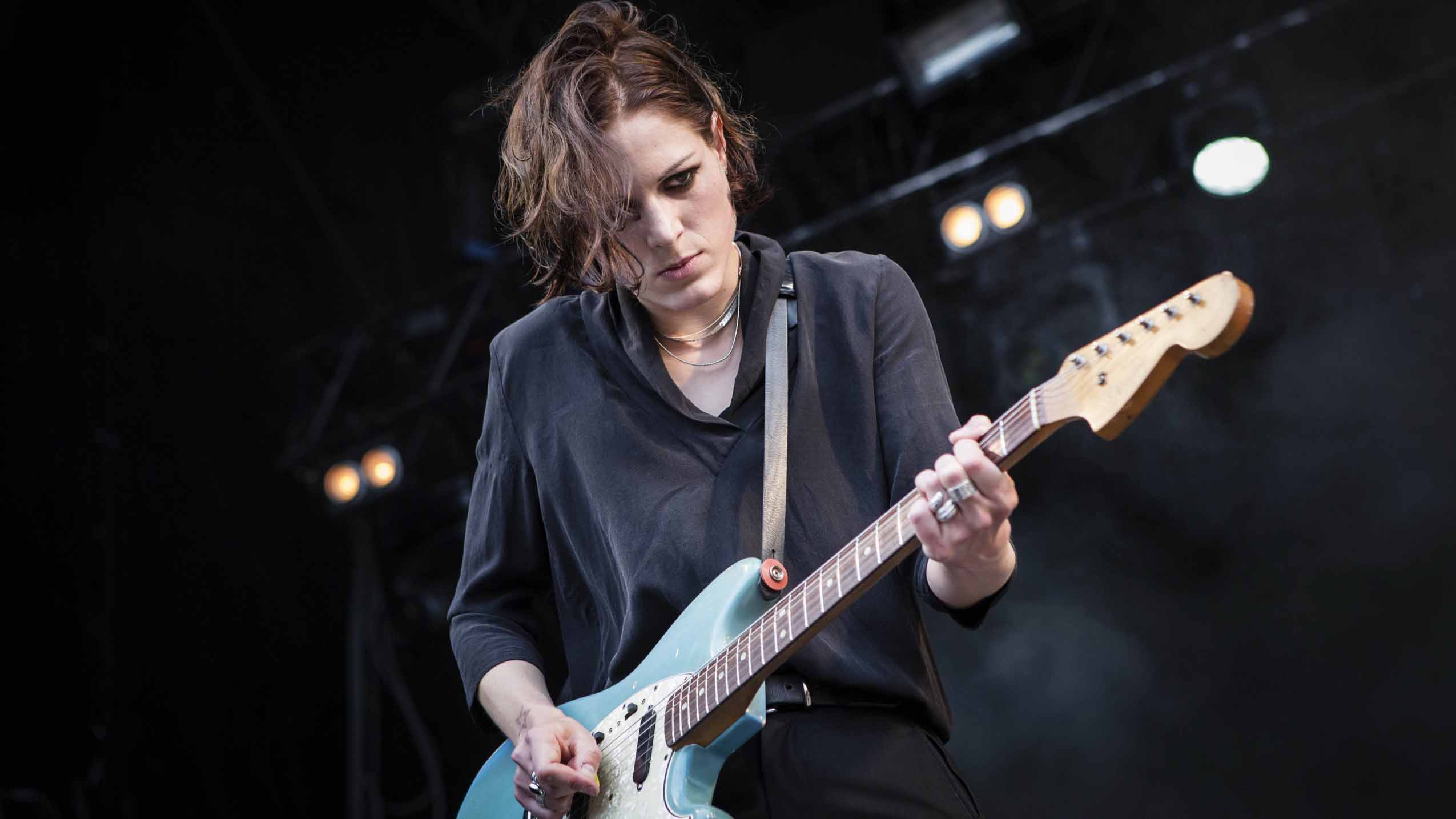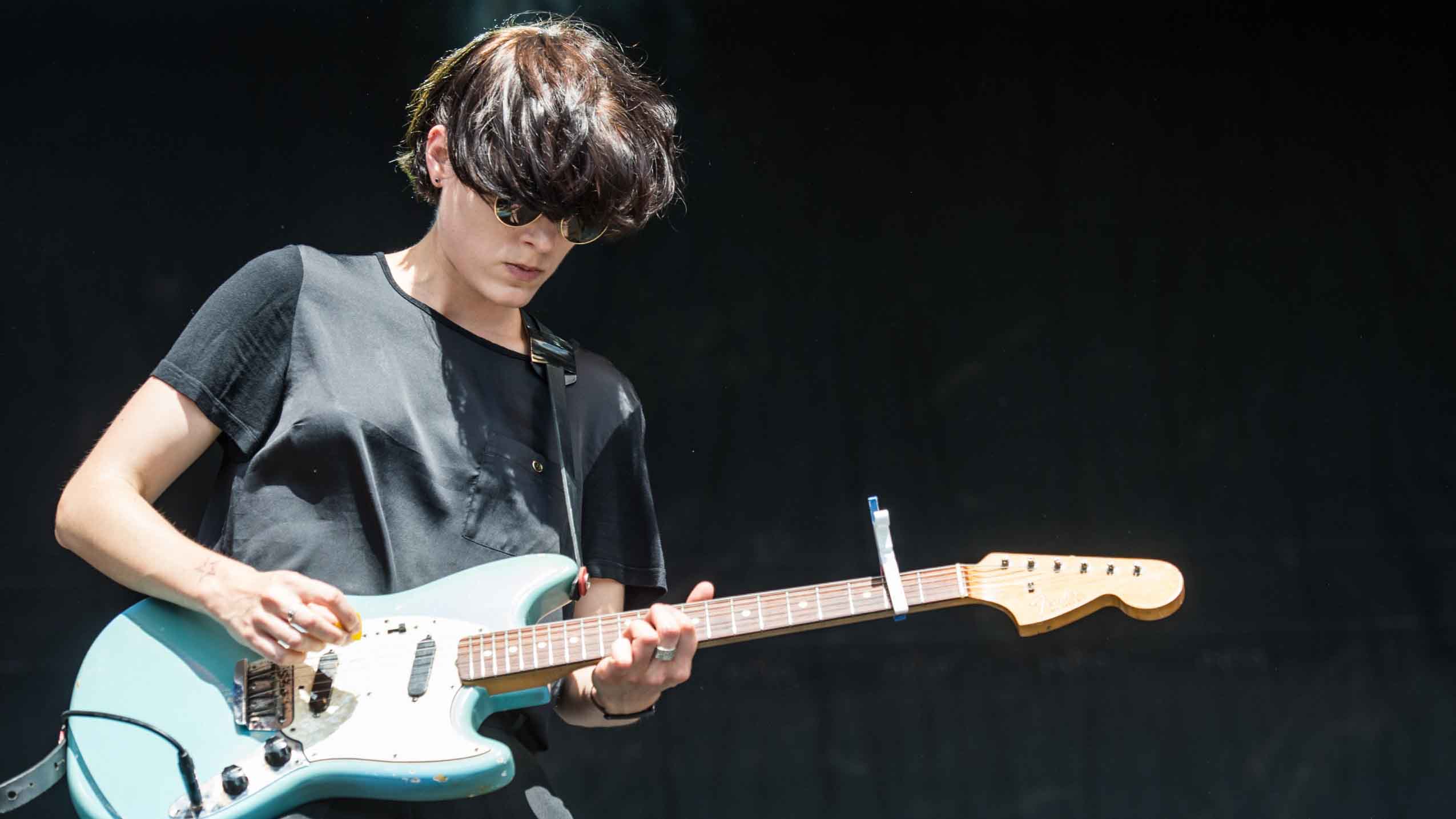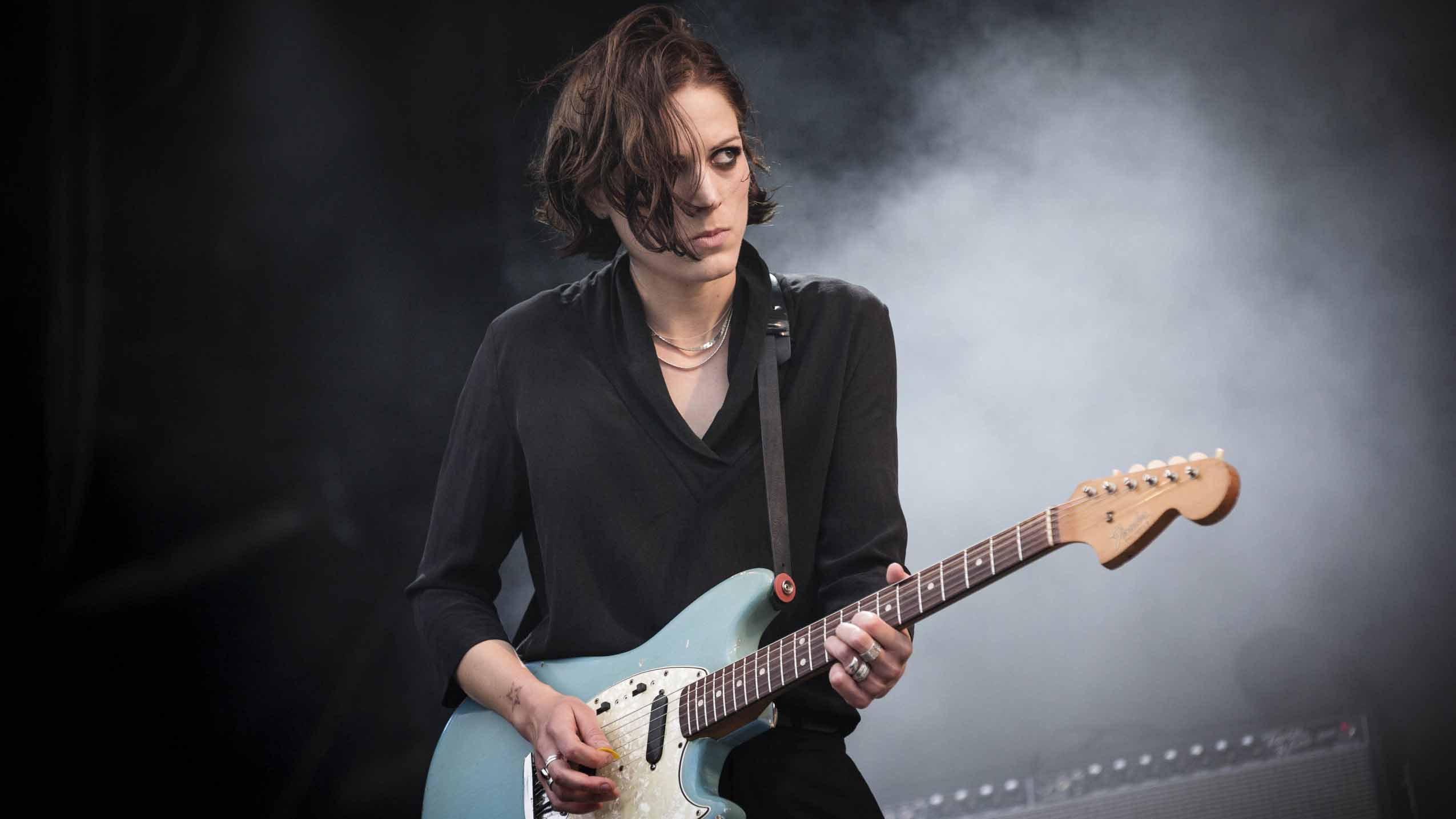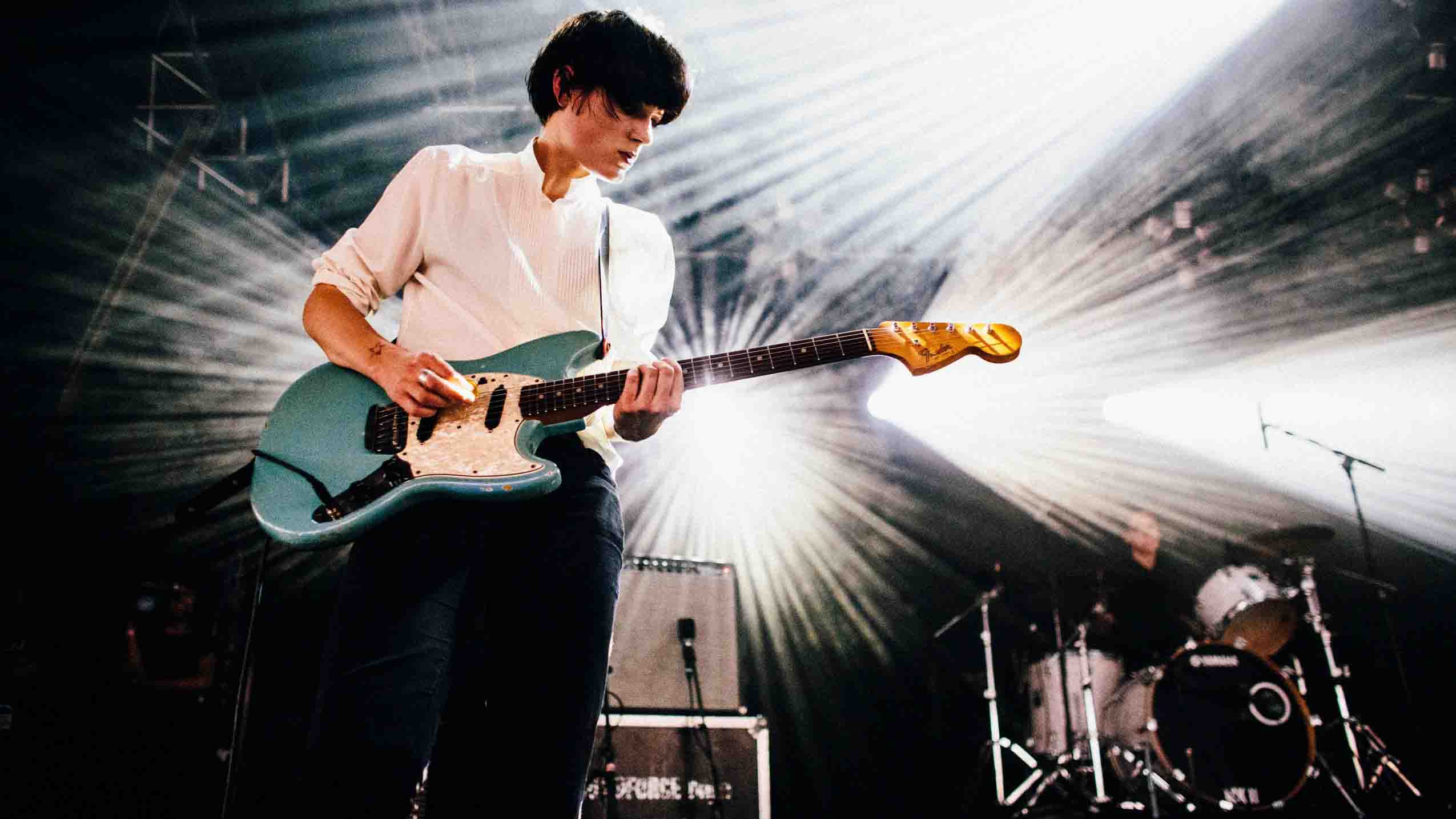Savages guitarist Gemma Thompson on sonic-shaking second album, Adore Life
Noise-rocker talks audience participation, feedback tones and art project beginnings

Introduction
Since first exploding onto the scene around four years ago, London noise-rock four-piece Savages have become one of the UK's most celebrated bands.
Their searing, in-your-face 2013 debut Silence Yourself soared to no. 18 in the album charts and Savages have since deservedly built up a rep for being one of the best live bands on the planet.
We quiz guitarist Gemma Thompson about the all-girl band’s killer new album, Adore Life…
SAVAGES UK TOUR - FEBRUARY 2016
Feb 18 De La War Pavilion, Bexhill
Feb 19 Cambridge Junction, Cambridge
Feb 21 Art School, Glasgow
Feb 22 Albert Hall, Manchester
Feb 23 Irish Centre, Leeds
Adore Life by Savages is out now.

Captive audience
It sounds like you approached the writing of Adore Life in an incredibly innovative way, with audience participation a key factor…
“We were very happy with the process. We spent three weeks in New York writing with the audience and then we came back to London and went into RAK Studios to record.
“All of that was very instinctive, I think, because the first record was such a document of live performance and trying to encapsulate that energy without doing any overdubs or too much extra over what we could do onstage. When we were going into this record, we thought, ‘We can’t just write new songs and go straight into the studio.’ Everything that we do is kind of focused towards being onstage, which is where everything works. We thought, ‘Let’s get out of London and find somewhere else with an energy and with an audience’.
Everything that we do is kind of focused towards being onstage, which is where everything works
“We thought we’d tell them beforehand so they’d know what the process was going to be and so they’d know that there were going to be elements of failure, like those times when you realise that something won’t work live. We wanted to put ourselves on the spot and there was an adrenaline to finishing writing the songs in that way.
“Over this course of three weeks, we had a rehearsal space and we had a residency at three different clubs, so we played nine shows in total. A lot of people I met came maybe to the first show and the last show but then a couple of people came to all of the shows. We started by putting a few new songs in the sets and then putting more and more new and half-written songs in.
“We were really trying to see how they would work and we gauged the audience to see what worked well. Most of the finished album is from those works that came out of the New York residency.”
From a guitar perspective, how far were some of your riffs and lead lines improvised or developed during the residency as opposed to being written beforehand?
“It’s kind of a strange mix of both, really. I guess there’s certain parts that you can’t really plan for. I would say that when we rehearse and write together, we’re actually very, very meticulous and we talk a lot about what we do.
When we rehearse and write together, we’re actually very, very meticulous
“We talk a lot about the lyrics and what they mean and where they’ve come from and what sounds would work with what but then there’s some things that you can’t really plan to write, especially on guitar. The guitar and vocals work together very closely and sometimes you just need to be onstage to work things out. Without that, you don’t always have that energy from the voice that can then work with the energy of the guitar.
“Sometimes, it was just each of us trying a little thing out at each show and then trying to guess what the other was going to do. That’s kind of what keeps it exciting. Sometimes, it was about gauging audience reaction, like when we played the early versions of Adore and we knew straight away that something wasn’t going to work so well live. Certain parts and changes maybe seemed confusing for people. I think we were just opening up the process and taking risks with it.”

It might get loud
How would you describe your approach to tone on this record?
“Through touring so much with the first record, I think there was much more of an understanding of how we each fit around each other. From a guitar perspective, I guess that would be in terms of balancing the frequencies of cymbals and the bass frequencies and certain distortions.
“I think, when we were writing for this record, I had very much that in mind for the guitar, about working with frequencies of bass. Also, I’d say there’s probably a little bit more melody with the guitar on this record compared to the first album, and I was really trying to work with the voice a bit more and listening a lot to that.
“I guess, since touring so much, we’ve also just become better musicians as well. I don’t think I’ve changed that much other than building on the base sounds that I already had on the guitar. I still try and work from a very simple core of the sound and try and make the manipulation of the guitar the main focus. Any effects that I have are to help and enhance the physical manipulation of the guitar rather than relying on an effect to do the work.
There are certain ungraspable harmonies that come from bass, guitar and cymbal volume
“On this record, I was just exploring things that have interested me from the beginning, like different feedback and then sound generated from volume, as well.
“There are certain ungraspable harmonies that come from bass, guitar and cymbal volume. There’s just kind of a swirl of this thing that you can’t achieve without certain levels. It’s been nice to be able to try all of those things out during the recording of this album.”
What guitars did you play on the album?
“Just before the recordings, I bought a beautiful Gibson 335 hollowbody and used that for an awful lot of feedback - really low-end resonating layers of guitar feedback. I used that with a noise pedal called the MXR Blue Box, which has been a really interesting combination. That guitar was a different world from what I was used to.
“My main guitar has always been a 1956 [Fender] Duo-Sonic II, which has really been everything for me up to this point but, when we were recording, I hired an early '70’s Fender Jag and really fell in love with that sound, as well. It was actually not too far from the Duo-Sonic sound.
“I then ended up buying a blonde 1963 Jag and it’s become a kind of dual/new main guitar now. There’s a lot more tone to it and it’s kind of a bigger beast. It’s definitely like trying to play with a different beast!
“Also, when I was in Istanbul for a very short time, I bought an electric saz and there’s actually a bit of saz on The Answer at the very end, where there’s a very drone-y repetitive part. I used it as a layer underneath but you can’t hear it… or maybe you can hear it if you know there’s a saz there!”

Tone-seeking
And how about amps?
“I had a week of guitar in one of the smaller studios at RAK with all of these wonderful vintage amps - old Fender Vibrolux amps and Vox AC30s from the '60s and weird little old tremolo late-'50’s amps. I’d just really turn them up to explore them with volume and with feedback.
“I had a whole row of amps and a switch system so I could go from one to the other or have a different combination. There was one called a Hohner Orgaphon from 1965, and I used that for weird tremolo sounds. That might have even been in The Answer – there’s a tremolo going through that.
“I think any other amps were always used in combination with a Vox AC30 from 1963. Live, I play through two amps in stereo, a Vox AC30 reissue with the handwired blue Alnico speakers alongside a Fender Twin or a [Fender] Silverface.”
What’s on your live pedalboard?
“It’s always changing, but there’s some that are always going to stay the same. I really like MXR pedals and, weirdly, the MXR Distortion+ has always worked really well for me. There’s quite an interesting tone to it.
“There’s a nice fuzz distortion pedal called the [Crowther Audio] Hotcake, and then I have a whole selection of other distortion/overdrive pedals, like the Maxon Tube Screamer and the [Fulltone] OCD pedal. I’ve also started playing around with the Moog Moogerfooger pedals: the drive pedal and the delay pedal.
“I always use a Boss DD-20 delay. Ever since I began guitar, I’ve always used that pedal, not so much because of the sound of the delay but more how it functions going from one delay to the other. You can program so many in the memory and go from one to the other and it flows really nicely… but I’m always trying out various bits and bobs.”
Effects pedals are meant to allow you to physically play the guitar but also push what you’re doing
How far do you use particular distortion pedals for particular songs?
“Yes, there’s always particular ones for particular songs. For The Answer, it’s always the Hotcake. It’s just the sound for it. But it’s been interesting actually going from the Duo-Sonic to the Jaguar because I found that the Jaguar likes the most analogue-sounding effects possible. It kind of fights anything that isn’t an analogue sound!
“I don’t know whether it’s this Jag in particular but, for example, it really likes the Moog pedals because the analogue delay sounds beautiful. I really like that idea that the guitar is almost trying to keep its own sound and be as natural as possible.
“I’ve always thought that that’s ultimately what guitar effects pedals are meant to do: they’re meant to allow you to physically play the guitar but also push what you’re doing, in a way. I think that’s always the way I’ve gone about it: not so that you’re relying on the effect itself, but that it’s pushing the way you’re actually physically playing the guitar.”

The art of guitar
Were there certain inspirations that made you pick up a guitar in the first place?
“I picked up the guitar originally because I wanted to make a soundtrack to a piece of work I was doing. I was studying Fine Art and I was living in a house full of musicians. I would photograph their shows, I used to paint backdrops for them and I’d go to every gig of theirs… but the house was always full of instruments.
“I was making an atmospheric soundtrack for something, and I borrowed a friend’s Strat and I just kind of worked through delays and a Big Muff pedal and just created this noise soundtrack. And, from that, I just continued playing noise guitar but without the intention of being in a band or anything.
“I was just interested in making this noise and this volume, and eventually, a friend said to me, ‘Will you join my band as a noise guitarist?’, and I kind of said, ‘Okay’.
I was never interested in being a technical guitarist. It was always more about the noise and more about physically embodying a sound
“I was never interested in being a technical guitarist. It was always more about the noise and more about physically embodying a sound or something. That must have been about nine years ago now. We were called Hindley and it was kind of a shoegaze noise band.”
Lastly, are there any guitarists who you think have notably influenced your style and development as a player?
“I guess, as a guitarist, Rowland S. Howard has been my kind of big inspiration in a way. It’s weird, because when I was introduced to his solo work, it only then dawned on me for some reason about his sound in The Birthday Party.
“There’s a song in particular – Happy Birthday by The Birthday Party – where there’s a guitar line in 3/4, and I remember hearing his guitar and thinking, ‘That’s exactly how I want to play. That’s the kind of sound that I want to create’. I didn’t realise that you can’t learn to play like that and that it can only come from being him.
I’m more interested in musicians who become the sound that they’re doing
“Duke Garwood is one of my heroes, as well, and guitarists like Blixa Bargeld and Kid Congo Powers. The Gun Club have been a real inspiration for me.
“I guess I’m more interested in musicians who kind of become the sound that they’re doing. It’s more about the energy that comes across and, as I said earlier, this band is really at its peak when we’re onstage and we’re performing, and that’s where everything just works out. Everything is towards the performance rather than anything else.”
Adore Life by Savages is out now.